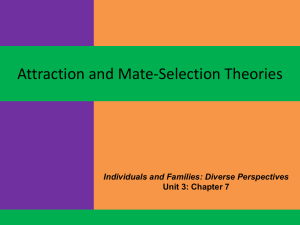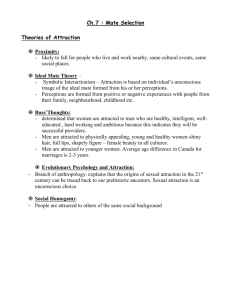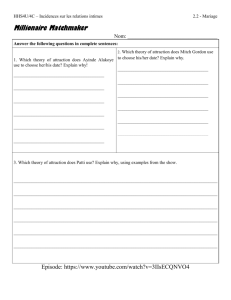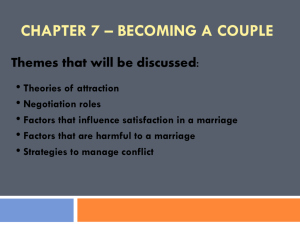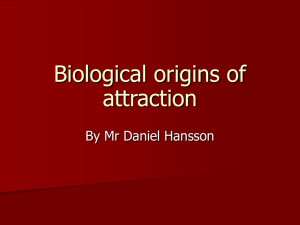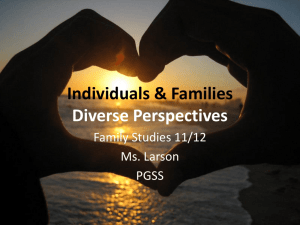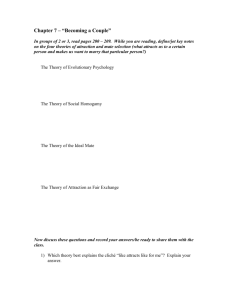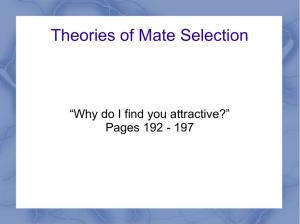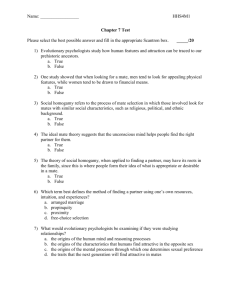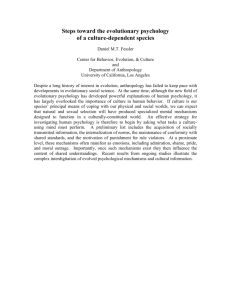15b_Chapter 7_Teacher Copy - HHS4M-Winter-2011
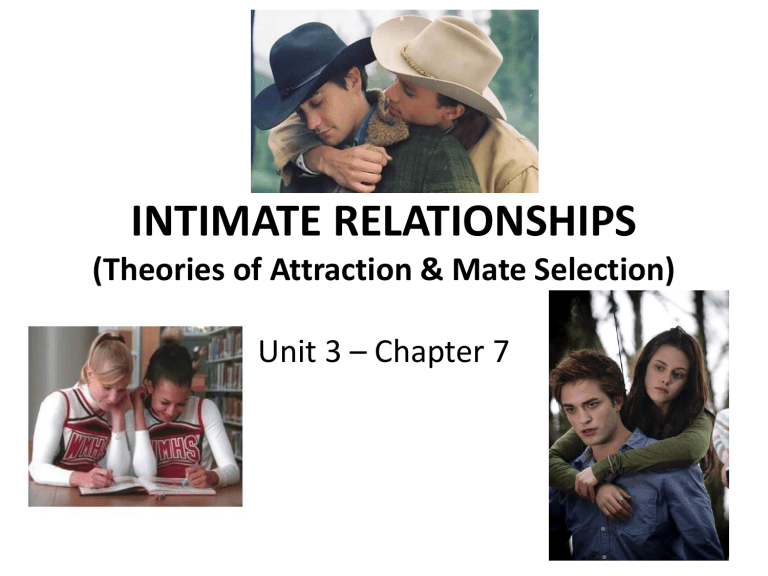
INTIMATE RELATIONSHIPS
(Theories of Attraction & Mate Selection)
Unit 3 – Chapter 7
Contemporary Marriages
• Sociologists estimate that only 10% of today’s marriages in the world are truly monogamous
• Polygyny and polyandry are more desirable by many people in the world but few people today can afford these marriages
• Serial monogamy (marriage to several spouses one after the other) is a result of divorce
Contemporary Marriages
• With immigration comes new ideas of marriage that disrupts the norms of Canadian marriage
• Increase in cohabitation and divorce rates suggests concern about whether marriages are meeting individuals’ needs
• However, newlyweds in most societies expect their own marriage will be for life regardless of the divorce rate
Evolutionary Psychology & Attraction
• Evolutionary psychology is a branch of anthropology
• Explains that the origins of sexual attraction today can be traced back to our prehistoric ancestors
• Sexual attraction is an unconscious choice, individuals seldom consciously control whom they find attractive
Evolutionary Psychology & Attraction
• Adaptive behaviours: strategies that enabled individuals to compete successfully for limited resources, to survive, to reproduce and to raise children
• Adaptive behaviours gave individuals an evolutionary advantage
• The theory of natural selection explains that individuals with an evolutionary advantage passed on their genes and their culture to the next generation
Evolutionary Psychology & Attraction
• David Buss (American anthropologist and evolutionary psychologist)
• “those who fail to mate, fail to become ancestors”
• Humans today have inherited the unconscious mating strategies that made our ancestors successful
Evolutionary Psychology & Attraction
• Anthropological evidence showed that attraction preferences in the past ensured that children were born and survived to adulthood to produce
• Helen Fisher identified adaptive behaviours for sexual attraction
Evolutionary Psychology & Attraction
• Women preferred to mate with men who had the resources to be good providers for themselves and their children because women were unable to both care for infants and gather enough food
• Men preferred to mate with women who could bear healthy babies who could feed their children and who had the intelligence and temperament to raise them well
(Helen Fisher)
Evolutionary Psychology & Attraction
• Prehistoric men formed lasting relationships because women could refuse sex until they got what they wanted or needed in evolutionary terms
• Children raised without a father were poorer and could not compete well in prehistoric society because they had less food and did not learn the necessary skill
(Helen Fisher)
Evolutionary Psychology & Attraction
• David Buss concluded that not much has changed about sexual attraction today
• Individuals are still attracted to the person with whom they can raise the most successful children with
• Men are attracted to physically appealing, younger and healthy women; women who appear to be fertile
Evolutionary Psychology & Attraction
• Buss determined that in all societies women seek to “marry up”
• Women are attracted to good providers
• Women are twice as likely as men to be attracted to an older mate with financial resources, even when they have substantial financial resources of their own
Evolutionary Psychology & Attraction
• Women are attracted to men who are healthy, intelligent, well-educated, hard-working and ambitious because these qualities enable men to be successful providers for their families in the long term
• In all cultures men and women wanted mates who were intelligent, kind, understanding, dependable and healthy
• Both seek the qualities that enable them to form satisfying and enduring relationships
Dating Ads from
• Man seeking woman:
• Description
I'm very real; sane, healthy, gentle, and generous. Looking for a kind, warm, sweet, sexy younger woman (19-38) for fun and friendship. No drama, no pressure sought.
Thanks
Dating Ads from
• Woman seeking man:
• Description
Attractive, well-educated and well-travelled female is looking for a gentleman (white, tall and handsome). Please don't write to me if you don't fit the above description as you are wasting your time. I wont reply to emails without a picture.
Thank you
Social Homogamy
• Proximity is a major factor in mate selection
• Individuals are attracted to, fall in love with, and marry those who live and work nearby, belong to the same religious community, or attend the same cultural events
Social Homogamy
• Explains how individuals are attracted to people from similar social and cultural backgrounds so that they share social, cultural and economic values and lifestyle expectations
• Highest correlations found in age, race, ethnic background, religion, socio-economic status and political views
Social Homogamy
• Education is a major factor in social homogamy
• Canadians are likely to marry someone with the same level of educational attainment
• Social homogamy helps to ensure that couples are compatible
Social Homogamy
• Similarity of backgrounds makes it more likely that couples will share common expectations for their relationship and their lifestyle, will manage their shared resources more efficiently and with less conflict, and will be able to raise children more easily
• Couples who have similar backgrounds are more likely to raise their children according to their cultural expectations
Social Homogamy
• Two people who have similar beliefs about the roles of husband and wife and who share similar expectations for their family life will enjoy each other’s company and will be more likely to fall in love
• Since most parents wish their children to have happy and lasting marriages and to pass on their cultural heritage to their children, social homogamy is also the basis of mate selection in societies that practice arranged marriages
Ideal Mate Theory
• Explains attraction from a symbolic
interactionist perspective
• Attraction is based on an individual’s unconscious image of the ideal mate formed from their own perceptions of the meaning of certain characteristics
Ideal Mate Theory
• Supports the concept of love at first sight
• Everyone has an unconscious ideal with which they compare a person to find him or her attractive or to make the immediate judgment of the person as lovable
Ideal Mate Theory
• Supports social homogamy
• Perceptions of an ideal mate are formed from pleasant experiences with other individuals in childhood, usually from a person’s family or from people within the community who are similar to oneself
• Individuals also react to negative experiences by identifying unattractive characteristics that they perceive will be unacceptable, the “deal breakers” for a successful marriage
Attraction as Fair Exchange
• Individual preferences determine who is attractive as a potential mate, but finding someone appealing does not guarantee that the feeling is mutual
• Individuals must compete with others to win the hand of the man or woman of their dreams
Attraction as Fair Exchange
• Social Exchange Theory suggests that attraction is based more on reality than fantasy
• Almost everyone, regardless of how attractive they might be, finds a mate in their society because individuals are attracted to different people so they don’t all search for the same ideal mate
• People assess the resources they have to offer and look for the best possible mate who will be attracted by these resources
Developmental Theories
• Individuals are not able to relate to someone else without understanding first who they are and what their roles in life are
• Individuals are not capable of a fully intimate relationship until the identity crisis of the transition to adulthood is resolved
• Committing to intimate relationships earlier would result in defining identity through the relationship
Developmental Theories
• Levinson and Erikson suggest women are more likely to define themselves through their connections with others and may develop a committed relationship as part of forming their identity
• Men prefer to retain more independence in their relationships and therefore might delay forming committed relationships until their life structures are established
Older Men & Younger Women
• Men marry younger women worldwide
• The average age difference for Canadian men and women is 2 years (one of the lowest in the world)
• The age difference can be explained by evolutionary psychology
• Older men who have proven resources are considered more desirable by women in all societies
• Younger women are considered more sexually desirable by men
Older Men & Younger Women
• Social Exchange Theory suggests that younger, more attractive women have greater resources to offer older, successful men
• Conflict and Feminist Theories suggest that a match between an older man and a younger woman ensures that the man has greater resources and that the younger woman will need his resources to acquire an improved lifestyle, the age difference is necessary for men to maintain a dominant status in a patriarchal marriage
Older Women & Younger Men
• Since women now have increased financial potential and extended fertility, they might prefer to marry younger partners
Millionaire Matchmaker
• Which theory of attraction does Mateo use to choose his date?
Millionaire Matchmaker
• Which theory of attraction does Jimmy D use to choose his date?
Millionaire Matchmaker
• Which theory of attraction does Patti use?
What is Love?
• Robert Sternberg, an American psychologist, interviewed hundreds of men and women who said they were in love and analyzed their responses to determine the qualities of romantic love and to distinguish between romantic love and friendship
• Sternberg determined that romantic love has
3 “faces”: passion, intimacy and commitment
Robert Sternberg
1) Passion, a strong feeling of sexual desire for another, develops the most quickly of the three. This probably results from a biological drive to reproduce.
Ex. Romeo and Juliet
2) The intense friendship of intimacy develops more slowly, as each individual shares his or her experiences, thoughts, and feeling with another and becomes willing to meet the other’s psychological needs
Robert Sternberg
3) Commitment to maintaining the relationship grows as the rewards of being in this relationship instead of in others become evident and individuals accept reciprocal roles and mutual interdependence
• Sternberg chose to represent love as a triangle so that relationships with various proportions of passion, intimacy and commitment could be depicted by varying the length of the sides
Sternberg’s Love Triangle
PASSION
Sternberg’s Love Triangle
• Love relationships based on intimacy require the individuals to fully appreciate each other’s uniqueness and separateness
• A companionate relationship requires an understanding of what one has to offer another and what one needs from another in return
